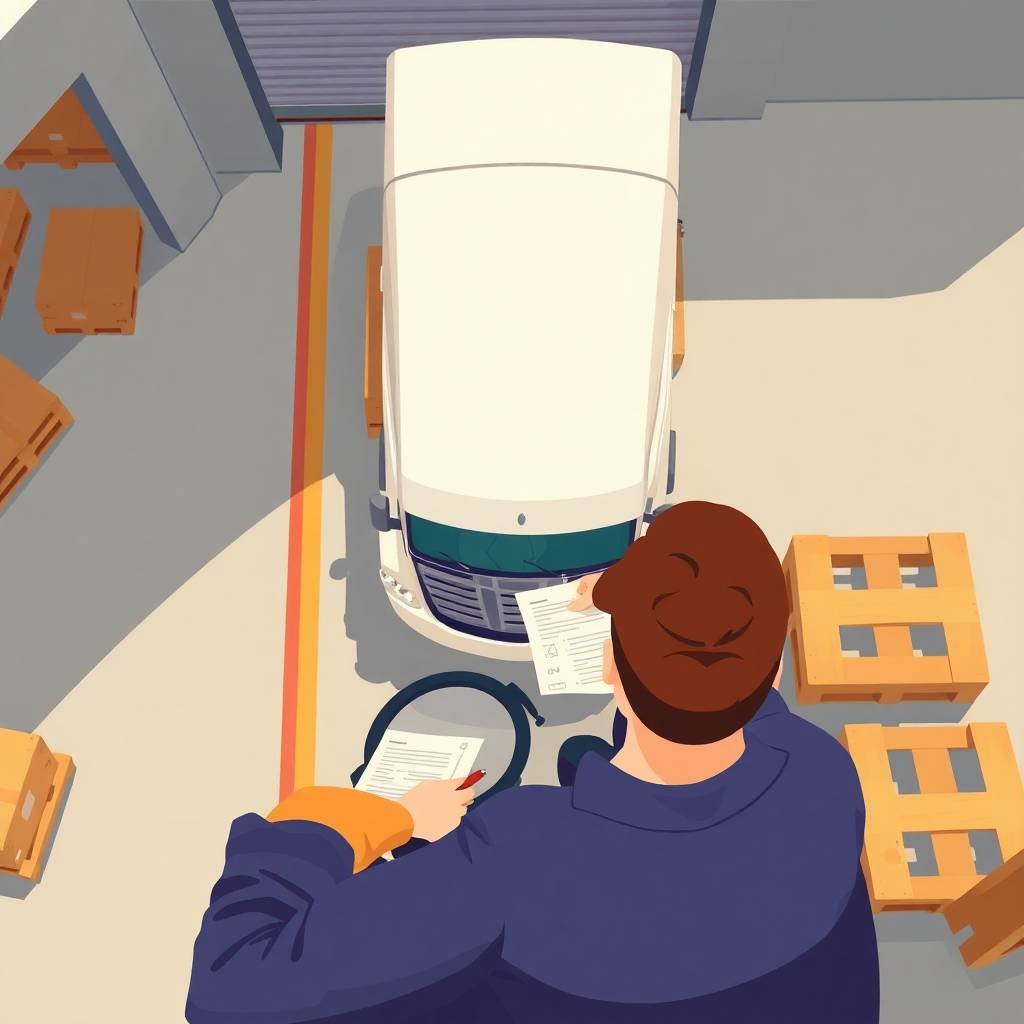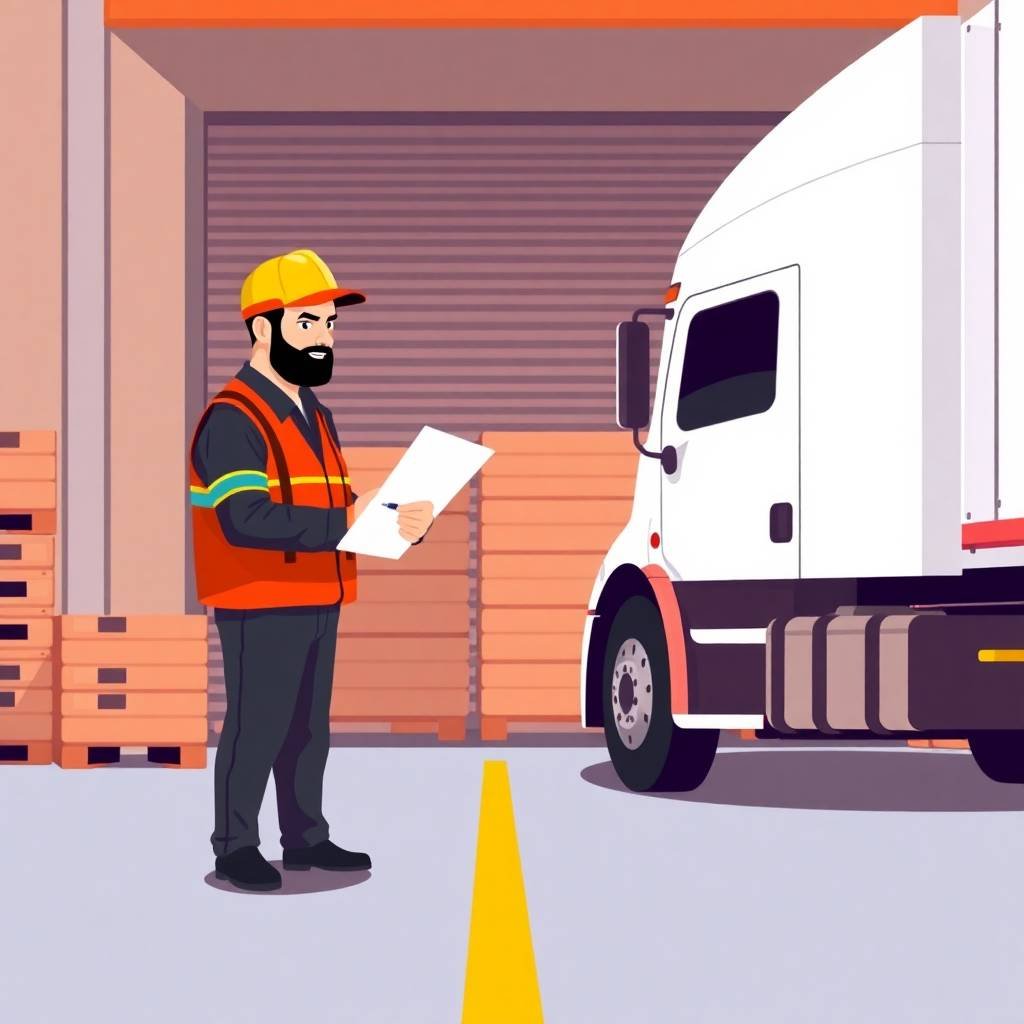1. Understand the FMCSA PIN Request Process Before You Start
For motor carriers and trucking companies navigating the world of DOT compliance, one of the first steps in managing your Federal Motor Carrier Safety Administration (FMCSA) responsibilities is understanding the FMCSA PIN Request Process. This process grants you access to your company’s safety data, application status, and regulatory compliance reports. Before diving in, it’s important to understand how the FMCSA PIN works, why it matters, and how to get started effectively.
What Is the FMCSA PIN?
The FMCSA Personal Identification Number (PIN) is a secure code issued by the FMCSA that allows carriers to access their safety records on FMCSA’s official portal. This PIN is essential for managing updates, reviewing inspection and crash data, and submitting forms such as the MCS-150. Understanding the FMCSA PIN Request Process ensures that your company avoids delays in compliance reporting and remains in good standing.
Why You Need to Understand the FMCSA PIN Request Process
Whether you’re a new entrant or an established carrier, the FMCSA PIN Request Process is foundational. Without this PIN, you can’t access the FMCSA Portal, which includes tools for monitoring CSA scores, submitting compliance data, and viewing critical alerts related to audits. Your PIN is also necessary during DOT audits. If you’re preparing for a review, check our DOT Audit Preparation guide for actionable tips.
How to Request Your FMCSA PIN
The FMCSA PIN Request Process is straightforward but must be followed precisely to avoid delays:
- Visit the FMCSA Portal.
- Navigate to the PIN Request page.
- Enter your USDOT number and company information.
- Choose the method of delivery—email or mail (note: email is faster).
- Verify your identity and submit the request.
To ensure a smooth experience, review the steps on our DOT Compliance Checklist and consider scheduling a consultation through our appointment link.
Common Challenges in the FMCSA PIN Request Process
One of the most frequent mistakes carriers make during the FMCSA PIN Request Process is entering incorrect business information or failing to update the MCS-150 form beforehand. Inaccuracies may delay the request or result in security verification issues. For additional help, refer to our article on FMCSA Compliance Mistakes.
Another pitfall is overlooking the importance of PIN security. If the PIN is compromised, it can lead to unauthorized access to your sensitive safety data. Always store your PIN securely and limit access to authorized personnel only.
What Happens After You Receive Your PIN?
Once you have your FMCSA PIN, you can:
- Access your Safety Measurement System (SMS) data. Learn how to interpret it with our SMS 2025 guide.
- Update your MCS-150 or biennial updates.
- Monitor your DOT compliance status.
- Prepare for new entrant safety audits. For insights, read our New Entrant Audit Survival Tips.
If you’re an owner-operator, our service page on DOT Compliance Checklist for Owner-Operators offers a detailed guide to help you stay compliant using your FMCSA credentials.
Additional Resources to Stay Compliant
Successfully completing the FMCSA PIN Request Process is just the start of your compliance journey. You’ll also need to stay current with:
- Drug and Alcohol Testing Compliance
- Driver Qualification File Requirements
- CSA Intervention Thresholds
- How to Correct FMCSA Violations
Our expert compliance services such as Drug and Alcohol Testing Management, Driver Safety Score Management, and IFTA/IRP/BOC-3 Support are designed to help you maintain full FMCSA compliance post-PIN activation.
Stay Informed and Take the Next Step
Visit our FMCSA Compliance Help page or explore our Compliance Services for Owner-Operators to get professional assistance after completing the FMCSA PIN Request Process. We also recommend reading the FMCSA Clearinghouse Compliance Guide and exploring our content on Driver Drug and Alcohol Testing Programs to further understand your obligations.
To stay updated, check out the latest posts at Truckers Compliance Hub and review the U.S. Department of Transportation’s website for federal updates.
By completing the FMCSA PIN Request Process correctly the first time, you eliminate compliance delays, improve operational oversight, and set the foundation for a safe and successful trucking business. If you have questions, don’t hesitate to book a 30-minute consultation with our compliance experts.
Please review our Disclaimer and Terms of Service for additional legal and service-related information.

2. Step 1: Gather Accurate Information Before Submitting Your Request
When it comes to the FMCSA PIN Request Process, the first and most critical step is gathering accurate and up-to-date information. The FMCSA PIN, or Personal Identification Number, is your gateway to managing compliance, monitoring safety data, and maintaining regulatory documentation. Failing to provide accurate details at the start of the process can cause unnecessary delays, rejections, or even compliance violations.
Before diving into the application, understanding the FMCSA PIN Request Process thoroughly will save your business time, money, and stress.
Why Accurate Information Matters in the FMCSA PIN Request Process
Accuracy is everything when initiating the FMCSA PIN Request Process. This PIN gives you access to sensitive areas of the FMCSA Portal, including your company’s safety profile, registration updates, and compliance submissions. The system verifies your details against federal databases, and inconsistencies can halt your request.
Incorrect information can also lead to compliance gaps. For example, if your company’s legal name, address, or USDOT number doesn’t match FMCSA records, your request will be denied or delayed. To avoid these mistakes, review our detailed FMCSA Compliance Checklist and ensure your information is aligned across all platforms.
What Information Do You Need?
To begin the FMCSA PIN Request Process, make sure you have the following on hand:
- Legal business name and DBA, if applicable
- Correct USDOT number
- Employer Identification Number (EIN)
- Updated contact details (phone, email, mailing address)
- Accurate MCS-150 information
If you’re unsure whether your MCS-150 form is current, visit FMCSA.gov and verify your data. You can also schedule a consultation through our appointment page for personalized help.
Common Mistakes That Cause Delays
One of the most common errors in the FMCSA PIN Request Process is using outdated or mismatched business information. These mismatches often stem from incorrectly filed MCS-150 forms or changes in company operations that haven’t been properly documented. We’ve outlined the most frequent FMCSA compliance mistakes to help you avoid these costly missteps.
If you’ve recently had issues with DQ file violations or driver qualification file requirements, it’s critical to resolve them before submitting your PIN request. You can use our driver safety score management services to improve your company’s standing.
Align With Broader FMCSA Compliance Requirements
The FMCSA PIN Request Process is only one aspect of your compliance journey. It connects directly with broader regulatory requirements, including drug and alcohol testing compliance, pre-employment testing, and ongoing random DOT drug testing. Ensure you are compliant in these areas before proceeding. We also provide full drug and alcohol testing management services for your convenience.
Additionally, if you are preparing for a DOT audit, your PIN will be required to access and submit necessary documentation. Be sure to read our full DOT audit preparation guide for 2025.
Helpful Resources for Completing Your PIN Request
We recommend starting with our full-service resource center, including guides on FMCSA compliance help for trucking companies and services for owner-operators.
These resources not only assist with the FMCSA PIN Request Process, but they also support areas like:
- CSA intervention thresholds
- UCR filing deadlines
- BOC-3, IFTA, and IRP support
- Correcting FMCSA violations
- New entrant safety audit survival
Each of these areas connects back to your FMCSA PIN and the need to access the portal accurately and securely.
Final Thoughts
The FMCSA PIN Request Process begins with ensuring your data is complete, consistent, and up-to-date. From your USDOT number to your business address and EIN, all details must align with FMCSA records. This step forms the foundation of your broader compliance responsibilities, including staying aligned with the FMCSA Safety Measurement System, managing a driver drug and alcohol testing program, and meeting all FMCSA compliance requirements.
For regular updates, insights, and industry news, visit our main site at Truckers Compliance Hub. To schedule a one-on-one compliance consultation, use our Calendly booking link.
As always, please review our Disclaimer and Terms of Service before using our content and services.
By taking the time to gather accurate information and understand the FMCSA PIN Request Process, you set your business up for long-term compliance and operational success.

3. Step 2: Choose the Right Method for Your PIN Request
After gathering accurate information for your company, the next crucial step in the FMCSA PIN Request Process is choosing the appropriate method to request your PIN. This step often seems simple, but understanding your options can save you time, prevent errors, and help you avoid compliance delays.
The FMCSA PIN Request Process offers different pathways depending on your business needs and the urgency of your request. In this guide, we’ll explain the available methods, how to choose the right one, and how this step connects to your broader compliance responsibilities.
Why the Method You Choose Matters
Choosing the correct method in the FMCSA PIN Request Process impacts how fast you receive your PIN and how easily you can access your FMCSA Portal. Whether you’re preparing for a DOT audit, submitting driver qualification file updates, or managing your FMCSA Safety Measurement System data, timely access is essential.
If you choose the wrong method or fail to follow the proper steps, your request could be rejected or significantly delayed. Our FMCSA compliance help for trucking companies and compliance services for owner-operators are designed to guide you through these challenges efficiently.
Available Methods to Request Your FMCSA PIN
The FMCSA PIN Request Process offers two primary options: online PIN requests and mailed PIN requests. Here’s how to choose the best one for your business.
1. Online PIN Request
This is the most convenient and fastest way to complete the FMCSA PIN Request Process. By visiting the official FMCSA website, you can select “Request a PIN” and enter your USDOT number and relevant identifying information.
This method is ideal if:
- Your company’s information (legal name, address, and USDOT number) is already up to date.
- You need access quickly for compliance submissions.
- You’re preparing for an audit or filing documents such as the MCS-150 update.
Be sure that all your data matches FMCSA records to avoid errors. Many trucking companies run into issues with outdated addresses or EINs. Use our DOT Compliance Checklist for Owner-Operators to verify your readiness.
2. Mailed PIN Request
This method is useful if you’ve changed your address recently or cannot access the email associated with your USDOT registration. The FMCSA PIN Request Process in this case involves requesting a hard copy PIN via U.S. Mail.
Choose this method if:
- You are unable to verify your company details online.
- Your previous PIN request failed due to mismatched information.
- You prefer a secure, paper trail.
However, the processing time is slower, and you could face delays in accessing crucial systems. For urgent needs like drug and alcohol testing compliance or pre-employment DOT testing, the online option is more efficient.
Need help selecting the right method? Schedule a consultation for personalized support.
Integrating Your PIN Into FMCSA Compliance
Your FMCSA PIN is the key to accessing critical areas of your operation, including driver safety score management, drug and alcohol testing management, and updating UCR filings.
Once you’ve completed this part of the FMCSA PIN Request Process, make sure you use your PIN to:
- Monitor violations using your SMS data
- Upload records for DOT audit preparation 2025
- Access your FMCSA Clearinghouse compliance status
Avoiding Common Mistakes When Choosing a Method
Many carriers face setbacks in the FMCSA PIN Request Process due to misunderstanding which method best suits their situation. Others fail to realize the PIN is tied to many compliance areas like random drug testing requirements or CSA intervention thresholds.
For a comprehensive guide to correcting any errors, refer to our post on how to correct FMCSA violations.
You can also view more insights on compliance strategy by browsing the Truckers Compliance Hub blog and reading about new entrant safety audit survival tips.
Final Thoughts
Choosing the right method in the FMCSA PIN Request Process sets the tone for your success with FMCSA compliance. Whether you choose an online submission for speed or a mailed PIN for accuracy, this step plays a foundational role in accessing systems that impact your operations daily.
For expert help and industry-proven solutions, explore our services for owner-operators and larger fleets alike. As you move forward, remember to read our Disclaimer and Terms of Service for full transparency.
Understanding and completing the FMCSA PIN Request Process properly ensures that you can stay on track with regulatory responsibilities, avoid penalties, and protect your business from compliance pitfalls.

4. Step 3: Track Your Request and Know When to Follow Up
Once you’ve submitted your request, the next essential step in the FMCSA PIN Request Process is tracking the status and knowing the appropriate time to follow up. Without this step, many carriers find themselves stalled—unable to access their FMCSA portal, update records, or stay compliant with federal regulations. This article will guide you through effective tracking strategies, follow-up timelines, and related compliance responsibilities to help you stay on course.
Why Tracking Is Crucial in the FMCSA PIN Request Process
The FMCSA PIN Request Process doesn’t end with submission. Whether you opted for an online request or chose the mailed version, tracking ensures you don’t miss critical compliance deadlines or delay actions such as DOT compliance checklist submissions or DQ file updates.
Tracking your PIN request helps prevent common compliance pitfalls, such as expired credentials or missing reports. For additional guidance on avoiding compliance errors, check out our article on FMCSA compliance mistakes.
Expected Timelines and Delivery Methods
Typically, FMCSA will issue your PIN within 7–10 business days for mailed requests and within minutes if you’re eligible for email delivery. However, delays may occur due to mismatched company data or address verification issues.
For online submissions, check your inbox and spam folders regularly. For mailed PINs, ensure your business mailing address matches the one on file with FMCSA. You can verify and update information through the official FMCSA portal or visit Transportation.gov for related updates and services.
If you’re unsure about how your information aligns with FMCSA records, consider scheduling a consultation with a compliance specialist.
How to Track Your FMCSA PIN Request
Tracking your request requires a proactive approach. Begin by documenting the exact date and method of submission. If you used the online system, you should receive a confirmation. Save this for your records.
Here are tips for effective tracking during the FMCSA PIN Request Process:
- Check your FMCSA portal weekly for any updates.
- Monitor your mail delivery if you requested the PIN by mail.
- Confirm your business address and legal name are correct using our DOT compliance checklist for owner-operators.
- Review your email spam folder if you expected digital delivery.
If you’ve gone over 10 business days without receiving your PIN, it may be time to follow up.
When and How to Follow Up
Following up too early can waste time; following up too late can lead to non-compliance. As a rule of thumb, if you haven’t received your PIN within 10 business days (or 3 days for email), initiate a follow-up.
You can:
- Contact FMCSA directly via their official website.
- Check the Truckers Compliance Hub blog for updates and tips.
- Speak with a compliance expert through our 30-minute consultation service.
Make sure you have your USDOT number, legal business name, and tracking reference (if available) ready when contacting FMCSA.
What to Do After Receiving Your PIN
Once you’ve successfully completed the FMCSA PIN Request Process, use your PIN to access compliance-critical systems. This includes:
- Managing your driver safety score
- Maintaining your FMCSA Clearinghouse compliance
- Updating IFTA, IRP, and BOC-3 documentation
- Ensuring ongoing drug and alcohol testing compliance
If any information is outdated or incorrect, use our guide on how to correct FMCSA violations to make the necessary changes.
Don’t Let Delays Derail Compliance
Delays in the FMCSA PIN Request Process can have ripple effects across your entire operation—from CSA intervention thresholds to new entrant safety audits. To avoid setbacks, have a follow-up plan and leverage our tools and services, such as:
- DOT audit preparation
- Drug and alcohol testing program management
- FMCSA compliance services for trucking companies
For owner-operators, our tailored services available here and here provide additional support.
Stay Ahead with Reliable Resources
The FMCSA PIN Request Process is just one part of staying compliant in the transportation industry. Explore more helpful articles like:
- Pre-employment DOT drug testing requirements
- Random DOT drug testing requirements
- DQ file violations and how to avoid them
Before using any of our services, please read our Disclaimer and Terms of Service for more information.
Final Thoughts
Tracking your request and knowing when to follow up is a critical step in the FMCSA PIN Request Process. It ensures you stay compliant, avoid unnecessary delays, and remain prepared for any upcoming audits or submissions. With the right strategy and resources, including expert consultation and support services, you can complete this process with confidence and keep your business on the road to success.

5. Step 4 & 5: Verify Your PIN and Secure It to Prevent Future Delays
As you progress through the FMCSA PIN Request Process, Steps 4 and 5 are critical for ensuring uninterrupted access to your FMCSA Portal and compliance systems. Once your PIN arrives, it’s not just about logging in—it’s about verifying accuracy and protecting it from future loss or compromise. This article will walk you through how to properly verify and secure your PIN, keeping your operations running smoothly and avoiding costly delays.
Step 4: Verifying Your PIN
Once you’ve received your FMCSA PIN, the first step is to confirm its functionality. Many carriers receive their PIN and assume all is well—until they attempt a log-in and encounter an error. To avoid setbacks, verify immediately upon receipt.
To do this, visit the official FMCSA website and attempt to log into the FMCSA Portal using your DOT number and the new PIN. If you encounter login issues, it may be due to incorrect company information on file or technical issues. Always confirm that the business name, mailing address, and USDOT number match exactly with FMCSA records. For more assistance with record corrections, refer to our guide on how to correct FMCSA violations.
If your PIN doesn’t work or you suspect an error, contact FMCSA or consider scheduling a 30-minute compliance consultation to troubleshoot with an expert.
Step 5: Securing Your PIN
Once your PIN is verified, securing it is just as important. Losing your PIN can delay access to important functions such as driver qualification file updates, drug and alcohol program reporting, and DOT audit preparation.
Here’s how to secure your PIN effectively:
- Store it in a password manager: Use a trusted password manager to store your FMCSA PIN securely.
- Avoid sharing: Only provide your PIN to authorized personnel within your organization.
- Keep a backup: Document the PIN in a secure offline location, such as a locked cabinet or encrypted digital file.
- Stay current with compliance requirements: Bookmark helpful resources like Truckers Compliance Hub to stay updated on regulations and FMCSA tools.
Proper security of your PIN not only protects your business but also ensures you can respond quickly to FMCSA requests, update records, and maintain timely submissions—key to avoiding compliance mistakes.
Why This Matters in the Broader Compliance Landscape
The FMCSA PIN Request Process touches nearly every aspect of your compliance operations. Without an active and secure PIN, you may struggle with:
- Submitting UCR filings
- Accessing your CSA scores
- Maintaining accurate driver safety scores
- Preparing for DOT audits
A missing PIN can also hinder your ability to complete crucial compliance tasks such as pre-employment drug testing, random drug testing, and staying compliant with the FMCSA Clearinghouse.
For a full list of essential compliance services and tools, explore our tailored offerings for trucking companies and owner-operators.
Keep Your PIN Handy for Future Use
Your FMCSA PIN will be required for:
- Updating your MCS-150
- Accessing the Safety Measurement System (SMS)
- Filing reports for IFTA, IRP, and BOC-3
- Responding to DQ file violations
Because of its wide range of uses, you should treat your FMCSA PIN with the same care as financial or legal records.
Supporting Your Compliance Beyond the PIN
Securing your FMCSA PIN is only one piece of the puzzle. Ongoing compliance requires attention to a range of responsibilities, including:
Staying ahead of these responsibilities can save time, money, and potential penalties. For regular updates, visit the Truckers Compliance Hub blog where we cover news, regulatory changes, and industry best practices.
Final Thoughts: Proactive Compliance Saves Time
Securing your PIN and verifying it immediately after receiving it are final yet crucial steps in the FMCSA PIN Request Process. Without these actions, you risk delays that could cascade into missed filings, failed audits, or non-compliance citations.
Whether you’re managing compliance requirements for trucking companies or are an owner-operator, taking these two steps seriously will help you maintain operational efficiency.
To ensure you’re fully compliant and prepared, explore our full service offerings and read our Disclaimer and Terms of Service for details.
Need help with your FMCSA PIN or compliance strategy? Schedule an appointment today and let our experts guide you every step of the way.

What is the FMCSA PIN Request Process and why is it important for carriers?

The FMCSA PIN Request Process is essential for motor carriers needing access to official FMCSA systems like SAFER and the FMCSA Portal. This unique PIN allows you to update company records, submit biennial updates, and manage safety compliance. Carriers often underestimate the time sensitivity of this process, which can lead to delays in completing critical filings. If you’re preparing for a DOT audit, securing your PIN early is crucial—DOT audit preparation support can ensure you’re fully compliant and ready.
How long does the FMCSA PIN Request Process usually take?

The timeline for the FMCSA PIN Request Process can vary depending on the method you choose—online requests typically take 4-7 business days, while mailed requests can take longer. To avoid delays, it’s important to verify your mailing address matches the one on file with FMCSA. Carriers who need to access PIN-dependent services quickly, like UCR filing assistance, should plan ahead and request their PIN early.
Can I expedite the FMCSA PIN Request Process if I have an urgent deadline?

Unfortunately, the FMCSA PIN Request Process cannot be formally expedited. However, requesting it online and ensuring your company’s information is accurate can help prevent unnecessary delays. If your PIN is needed to access systems for IFTA or IRP registration, you may want to consult our IFTA, IRP & BOC-3 support services to streamline your registration and compliance efforts while you wait.
What should I do if my FMCSA PIN doesn’t arrive or is incorrect?

If your PIN is delayed or incorrect, the best course of action is to verify your FMCSA registration details and re-submit the request. In the meantime, services like DQ File Setup and Monitoring can help ensure the rest of your compliance documentation is in order while resolving issues with the FMCSA PIN Request Process.
How does the FMCSA PIN Request Process relate to ongoing compliance programs?

The FMCSA PIN Request Process is directly tied to your ability to manage compliance requirements. Without a valid PIN, accessing your FMCSA Portal or updating records becomes difficult, potentially leading to noncompliance. Programs such as Drug and Alcohol Testing Management also require FMCSA system access to document compliance correctly, making your PIN a foundational tool in your safety and regulatory strategy.
Igor Iturriaga is a transportation compliance expert and founder of Dynamic 305 Miami LLC. He helps owner-operators and fleets stay FMCSA-compliant and audit-ready. https://www.linkedin.com/in/igor-iturriaga-64503217/
